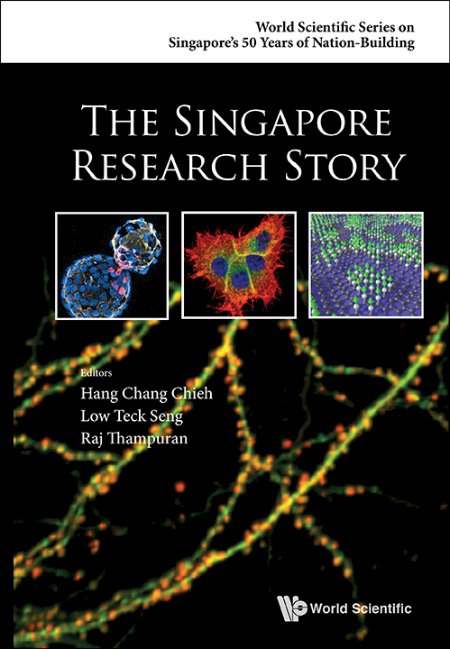Cookies Notification

World Scientific Series on Singapore's 50 Years of Nation-Building
The Singapore Research Story
- Edited by:
- Chang Chieh Hang (Institute for Engineering Leadership, NUS, Singapore),
- Teck Seng Low (National Research Foundation, Singapore), and
- Raj Thampuran (A*STAR, Singapore)
Ever since Singapore became independent in 1965, its leaders have invested tremendous efforts and resources to develop its economy in order to create jobs for its people and to support national development. This book describes the challenging journey of Singapore in developing a knowledge-based economy driven by research and innovation and the roles played by research institutes, universities, research manpower and appropriate collaboration between research institutes and industry.
The book traces the foundations of Singapore's research story from the time of its independence in 1965 to the present day. Through interviews with the key players and research into the records, the establishment of the key institutes and the roles of a global cast of researchers, scientists and engineers in setting up the R&D infrastructure are outlined. The impact of the concerted efforts to build up a credible and world-class research capability in Singapore over the last 25 years is discussed, as are the tremendous challenges faced by the key players in the drive to develop a knowledge-based economy and the ultimate goal of an innovation-driven economy.
Sample Chapter(s)
Foreword (55 KB)
Introduction (74 KB)
Chapter 1: Setting the Stage (195 KB)
Contents:
- Foreword by PM Lee Hsien Loong
- Acknowledgements
- Cover Photo Credits
- About the Contributors
- Introduction
- Setting the Stage (Hang Chang Chieh and Yeoh Keat Chuan)
- Shifting Gear into Research (Hang Chang Chieh, Low Teck Seng and Yeoh Keat Chuan)
- The Multi-Agency Approach (Hang Chang Chieh, Low Teck Seng and Raj Thampuran)
- Research in Physical Sciences and Engineering (Hang Chang Chieh and Raj Thampuran)
- The Biomedical Sciences: Research for Better Health (Raj Thampuran and Kong Hwai Loong)
- Developing Research-Intensive Universities (Barry Halliwell and Bertil Andersson)
- Partnering Multinational Corporations in R&D (Low Teck Seng, Raj Thampuran and Yeoh Keat Chuan)
- Developing R&D in Local Enterprises (Hang Chang Chieh, Raj Thampuran and Png Cheong Boon)
- Towards Innovation & Entrepreneurship (Low Teck Seng, Raj Thampuran, Tan Kai Hoe and Philip Ong)
- Appendices:
- Singapore's Science & Technology, R&D Timeline
- Chairmen, Executive Directors and Directors
- Honouring Scientific Talent
- Oral History Interviews
- Acronyms
- Select Bibliography
- Index
Readership: Researchers, professionals, academics, and laymen interested in all aspects of research and development.
FRONT MATTER
- Pages:i–xxi
https://doi.org/10.1142/9789814641272_fmatter
The following sections are included:
- Foreword
- Contents
- Acknowledgements
- Cover Photo Credits
- About the Contributors
- Introduction
Chapter 1: Setting the Stage
- Pages:1–24
https://doi.org/10.1142/9789814641272_0001
Fifty years ago, the stage for the development of today's R&D landscape was fledgling. In 1965 when Singapore became independent after a little less than three years in the Federation of Malaysia, the state of science and technology in all sectors was at very low levels. Science and engineering education was basic and limited. Statistics for 1960 show that the total enrolment in educational institutions was 352,952, of which only 8,171 were in universities and colleges, and just 1,257 in technical and commercial institutions. The tertiary institutions were English-medium University of Malaya in Singapore, Chinese-medium Nanyang University, Teachers' Training College for training teachers and Singapore Polytechnic, the latter two set up only in 1954 when Britain began taking steps to divest itself of its Southeast Asian colonies. The University of Malaya in Singapore (later the University of Singapore) had started its Engineering Faculty in 1955 — but in Kuala Lumpur on the premise that the newly set-up campus should have at least one professional degree course given that the medical and law faculties were both in Singapore. The pre-university science classes numbered just eight and prepared students for education in medicine, science and engineering, with the majority going into medicine or science, engineering being lower down the list of desired professions. The medical school had in fact been the first institution of higher learning, starting in 1905, in part because healthcare in the Colony of Singapore was already an important concern. As an open port, Singapore saw (and still does) a constant stream of ships, sailors, migrant workers and travellers who brought diseases that spread easily in the unsanitary and poor housing conditions of those times. Public healthcare had been the spur for the setting up of a unit in the Municipal Government that identified diseases, poisons, drugs and other public health issues circa 1885, evolving subsequently into the Department of Scientific Services. This department eventually evolved into the Forensic Science Division, Singapore's oldest scientific facility.
Chapter 2: Shifting Gear into Research
- Pages:25–54
https://doi.org/10.1142/9789814641272_0002
After 1965, Singapore's economy had expanded rapidly notwithstanding the 1970s oil crisis and downturns elsewhere in the world. Even in a bad year, GDP growth was about 5% while in a boom year it stood at about 15%. Between 1980 and 1984, real GDP growth averaged 8.5%. The Economic Committee which was set up in 1985 to review the economy published its report titled The Singapore Economy: New Directions in February 1986. It concluded: “The period of easy growth is now over. The recession of 1985 and 1986 is a turning point in our economic development. Even after we overcome this recession, economic growth will not rebound to its previous average of 9%. Internally we have finished doing all the easy things that can foster growth. Externally, international trade is no longer expanding as exuberantly as it used to, and worse, the trading environment is becoming increasingly hostile. From now on growth will be harder to achieve.” The report identified some internal factors that contributed to the slowdown. One was the high wage policy of the late 1970s. The policy had been instituted by the National Wages Council (NWC), a tripartite body made up of employers, trade unions and the Government, and formed in 1972 to formulate wage guidelines. NWC had been formed at a time when Singapore was industrialising rapidly and facing a growing labour crunch. Raising wages was one way to attract more people into the work force. The higher wages cut into Singapore's cost competitiveness at a time when regional economies with much cheaper and more plentiful labour were competing for these jobs. Other operating costs — rentals, interest costs, statutory board charges — also went up, further decreasing Singapore's cost competitiveness. The Report contained detailed changes to specific policies but the four key recommendations were wage reform, tax reform, upgrading of business efficiency and productivity, and promotion of services. Manufacturing had to remain a core component of Singapore's economy as it would provide a wide range of employment opportunities. The Report noted: “Since 1983, strong expansion in new high value-added industries such as computers, electronics, machinery, printing and pharmaceuticals provided the impetus for growth. This was achieved through a high rate of new and better quality investments in these industries.” The Report also noted that the high GDP growth of the first half of the 1980s was generated largely by the strong growth of international services which accounted for 33% of GDP or about 1.5 times the manufacturing share. Productivity growth in this sector averaged 8.5% per annum. “The present level of value-added per worker in these services, $48,000 in 1980 factor cost, is twice the national level.” It was clear that Singapore's economic restructuring had to focus on adding value to the different sectors, and developing the capacity to add value. One source of higher value-added would be higher productivity. The Report said: “Analysis of our performance in the last two decades shows that productivity growth depends on three main factors:
- Increases in capital-intensity, as measured by the rate of growth of investments in machinery and equipment per worker;
- Increases in the proportion of professional and technically-skilled workers engaged in knowledge-intensive occupations; and
- ‘Technical progress’, i.e. qualitative improvements in the overall efficiency of our businesses”
Chapter 3: The Multi-Agency Approach
- Pages:55–78
https://doi.org/10.1142/9789814641272_0003
Behind the iconic Fusionopolis and Biopolis is a whole complex network of invisible links, local and international, that forms Singapore's R&D ecosystem. It is a multi-layered system that leverages on its links, and whose strength lies in the ties, partnerships and collaborations that span the globe as well as internally within Singapore. These ties have been in the making since Singapore became self-governing in 1959, and economic development, progress and restructuring was adopted as the underlying national philosophy, the benefits of which can be seen today. The principles behind these ties are inherited from the earliest days when Singapore began industrialising to develop the economy and create jobs. In Heart Work: Stories of How EDB Steered the Singapore Economy from 1961 into the 21st Century, lead author Chan Chin Bock said in the opening lines of his preface: “Singapore's economic pioneers — former Cabinet Ministers Goh Keng Swee and Hon Sui Sen — have left a very valuable legacy to the Singapore Economic Development Board. It is the legacy of first learning from others, and then adapting new knowledge to apply to the Singapore we want.” This is one of the underlying principles that shifted Singapore towards a knowledge-based economy and the development of a vibrant R&D ecosystem. Singapore learns from the more knowledgeable around the world but it also learns from its own history.
Chapter 4: Research in Physical Sciences and Engineering
- Pages:79–100
https://doi.org/10.1142/9789814641272_0004
In 2001, there was a change of leadership in NSTB, with Philip Yeo, chairman of EDB, taking over from Teo Ming Kian who then became chairman of EDB. Yeo called for a reorganisation of NSTB for a more targeted focus on R&D: he wanted to develop Biomedical Research but he also wanted to attract more industry players to the Science and Engineering R&D landscape. Until 2001, NSTB was basically a planning and funding agency. All the mission-oriented research institutes (RIs) and centres that had been set up with NSTB funding were being managed by the universities. Consequently, there were overlapping research objectives in some of the research centres. Yeo decided that it was time for NSTB to take over active management of the RIs as well as further strengthen their links with industry. Thus, Prof CC Hang was persuaded to become full-time Executive Deputy Chairman of the renamed NSTB, now A*STAR, with the task of rationalising the engineering RIs, grouping them, through the coordination by a Science and Engineering Research Council (SERC). The concept of R&D management through councils was similar to the structure of the UK's Engineering and Physical Sciences Council. Like each of the RIs, the Council would have a panel of international advisors from universities, research institutes and industry leaders. In parallel, Yeo himself was driving the start of the Biomedical Sciences (BMS) Initiative and the formation of the Biomedical Research Council (BMRC) to coordinate the setting up of new research institutes to supplement the role of the Institute of Molecular and Cell Biology (IMCB).
Chapter 5: The Biomedical Sciences: Research for Better Health
- Pages:101–133
https://doi.org/10.1142/9789814641272_0005
Singapore's interest in biotechnology goes way back to the late 1970s at the time that the EDB had succeeded in getting Glaxo (today GlaxoSmithKline) to invest in Singapore and build a plant to produce Zantac. Glaxo was the second pharmaceutical company in Singapore. The first pharmaceutical company to set up in Singapore had been Beechams, a company founded by British chemist Thomas Beecham who, in 1854, started the first-ever factory solely to produce medicines. Beechams had come to Singapore in 1972 to produce the antibiotic Amoxicillin. Beechams' presence in Singapore was an encouragement to Glaxo when it was looking into a place to set up manufacturing of Ranitidine Hydrochloride, the active compound for Zantac, that had been discovered in the 1970s. In 1979, Glaxo inked a deal with EDB to set up a plant in Singapore to manufacture Ranitidine Hydrochloride. The Glaxo plant which went into production in 1982 was the first pharmaceutical plant here to go through a US Food and Drug Administration inspection for which it got a clean bill of health. Zantac would become one of Glaxo's most profitable drugs and would make Glaxo one of the leading pharmaceutical companies by sales revenue. After 1979, local media began carrying stories about biotechnology programmes. The Zantac project would also sow the seeds for Singapore's biotechnology programme. In 1982, Dr Christopher YH Tan, a Singapore-born researcher who was a tenured professor at the University of Calgary noted internationally for his research on Interferon was asked to meet Dr Goh Keng Swee who was at that time First Deputy Prime Minister, Minister for Education, and the chairman of the Monetary Authority of Singapore.
Chapter 6: Developing Research-Intensive Universities
- Pages:135–164
https://doi.org/10.1142/9789814641272_0006
Whatever critics may think of global rankings, it is of some significance that Singapore's two major universities, National University of Singapore (NUS) and Nanyang Technological University (NTU) both feature in the Quacquarelli Symonds (QS) World Rankings in the top 40 universities in the world. Such rankings are based on research publication in benchmark peer-reviewed scientific journals, reputation among global academics, etc. It is a significant achievement for a small country that only started on the journey to research excellence with the establishment of the National Science and Technology Board (NSTB) in 1991, the same year as NTU's establishment. Although other measures of excellence must also be taken into account, what they do indicate is the effectiveness of the national investment in education and research as part of the Singapore Government's overall commitment to create a vibrant knowledge-based economy. Without such a commitment, building up research-intensive universities would not have been possible. In tandem with the mission-oriented RIs under NSTB/A*STAR, the universities play important roles in the R&D ecosystem. They came in for more attention as A*STAR and the National Research Foundation (NRF) started to spearhead thematic research programmes and fund the universities on emerging science and engineering topics and in areas with potential to become upstream resources for the RIs further downstream. Already an important part of the R&D landscape since the earliest days of any kind of interest in science and technology, the universities are today an even more important component of the R&D hub plan with the creation of the Research, Innovation and Enterprise Council (RIEC) and the NRF. When NRF started to look at emerging areas and embarking on this new strategy of funding new and strategic basic research, the universities came into focus. Unlike A*STAR, NRF is essentially a funding agency and does not manage any research institutes. NRF funds R&D projects that are expected to have longer-term national impact. Thus in 2006 one of the first NRF programmes was $500 million for water research, a sustainable and secure water supply being a continuing national issue, notwithstanding the success of NEWater, a PUB-initiated project in the late 1990s to look into recycling water. Another project in which NRF has invested funding is research into how dengue fever spreads. The National Environment Agency manages the project and turns to the universities and research institutes to learn more about ways to prevent and mitigate the spread of dengue, the diagnosis and treatment options, identification of virus types and distinguishing symptoms. The universities are in the thick of such research projects.
Chapter 7: Partnering Multinational Corporations in R&D
- Pages:165–187
https://doi.org/10.1142/9789814641272_0007
Multinational corporations or MNCs have been the engine of manufacturing growth ever since the EDB began wooing them to set up operations here. In the late 1980s came the economic restructuring that banked on developing R&D capability to create an additional value proposition for extant MNCs to remain in Singapore while attracting new ones here. It was no longer competition on the basis of lower costs but rather on how much smarter the Singapore economy could be. Making the paradigm shift to a knowledge-based economy would give Singapore competitive advantages because a knowledge-based economy capitalises on people, education and experience rather than on mere price. From Singapore's earliest engagements with the MNCs, it benefitted from close collaboration with them as they were responsive to emerging trends that did not as yet have names. In the late 1960s, the relocation of MNCs to Asia — and the globalisation of the world economy — had been prompted in part by US companies wanting to take advantage of comparative gains from lower costs to be found in global manufacturing. Such lower costs came in part from outsourcing the more peripheral aspects of manufacturing as well as from cheaper labour costs. Singapore's choice of manufacturing for export in place of import substitution manufacturing had tapped into this emerging trend. Looking to lower operational costs, MNCs were breaking up traditionally integrated manufacturing, relocating and using local SMEs to make some of these components. The vertical disintegration of large companies benefitted the emerging industrialising countries such as Singapore. As US and Japanese companies moved manufacturing overseas the production of components came to be outsourced increasingly. MNCs partnered local SMEs and set up supply chains that became increasingly complex and global in nature. Such local SMEs moved up the technology ladder as a consequence, as did the workforce which had to keep up with the new technology. By the end of the 1980s, the process of vertical disintegration, technology transfer and divesting of certain services through the setting up of global supply chains outside the company had come to be termed “ outsourcing”. This was a trend, now an established practice, identified by management and business school gurus at the end of the 20th century. Except for the most basic, many products today are made up of parts and intellectual property that come from everywhere, sometimes from rivals. Globalised economies emerged, and “ globalisation” joined the list of newly-minted economic terms and realities.
Chapter 8: Developing R&D in Local Enterprises
- Pages:189–216
https://doi.org/10.1142/9789814641272_0008
Local enterprises may be categorised according to economic clusters. There are three main clusters: first, Manufacturing and Engineering comprising Precision Engineering, Electronics, Printing, Packaging, Chemicals, Transport Engineering, Cleantech and Engineering Services; second, Lifestyle comprising Food Manufacturing, F&B Services, Retail, Textile and Fashion, and Furniture; and third, Services and Biomedicals comprising Logistics, Professional Services, Education Services, Healthcare Services, and Biomedicals. Local enterprises may also be divided by size into two groups: larger local enterprises and SMEs. The first group of larger local enterprises comprise companies that may be listed on the Singapore Stock Exchange as well as Singapore-based multinational companies (MNCs). (This chapter deals only with local enterprises. For MNCs see Chapter 7.) Some of the larger local enterprises are technology-intensive companies that may have originated as government-linked companies. Examples in this group would be Singapore Technologies Engineering Ltd, Keppel Off shore and Marine Ltd, and Sembcorp Industries Ltd. Also in this group of larger local companies are those that grew into established companies through effective entrepreneurial leadership. Hyflux Ltd is a well-known example. This group also includes enterprises in the food industry which was one of Singapore's earliest industrialised sectors. Examples are Khong Guan Biscuit Factory (S) Pte Ltd (founded 1947), Yeo Hiap Seng Ltd (now YHS, originated as a soya sauce producer in Fujian Province, China, in 1900) and Amoy Canning Corporation (S) Ltd (incorporated in 1951 in Singapore but started up as a soya sauce producer in Xiamen, China, in 1907). The food industry here was among the earliest sectors to invest in R&D to raise safety and manufacturing processes to international standards, largely through the efforts of the Singapore Institute of Standards and Industrial Research (whose quality and standards components are now under SPRING Singapore). The second group of local enterprises comprise Small and Medium Enterprises (SMEs) numbering 183,400 or 99% of the total of local enterprises (2014 figures). Out of this total of SMEs, 79% consist of micro enterprises with annual sales turnover of up to $1 million, 16% of small enterprises with turnover of $10 million and 5% of medium enterprises with turnover of $100 million.
Chapter 9: Towards Innovation & Entrepreneurship
- Pages:217–242
https://doi.org/10.1142/9789814641272_0009
In its efforts to leverage on research to promote and drive Innovation & Entrepreneurship in both public and private sectors, and in both MNCs and local enterprises, in order to achieve growth, Singapore is beginning to see some successes. Compared to its significant investments in research capability and capacity since the 1990s, the focus on commercialisation and new businesses has only been in the last 10 to 15 years. This can be seen, for example, from the establishment of the Action Community for Entrepreneurship, a public-private partnership to foster entrepreneurship, in 2003; and the renaming of the national “Science & Technology” Masterplan to the “Research, Innovation and Enterprise (RIE)” plan to lend greater focus on innovation and enterprise. For local enterprises, this is a new game. It goes beyond R&D, into design-driven innovation, Open Innovation, Business Model Innovation, etc. The commercial successes of a few large local enterprises and the timely upgrading of high-growth SMEs through the GET-Up Programme of A*STAR and SPRING Singapore (as elaborated in Chapter 8) give hope that with further persistence and entrepreneurial skills, more Singapore SMEs will grow by launching more innovations in the near future. University and polytechnic education will need to be enhanced to provide training and hands-on experiences for engineering students to learn design-thinking, create viable business models, and develop awareness of technology commercialisation, techno-entrepreneurship, open innovation strategies, etc. Entrepreneurs like Sim Wong Hoo and Henn Tan are examples of these possibilities. There is evidence that with pro-active and substantial nurturing of talent and ideas more such entrepreneurs and companies can develop. Many more university and RI spin-off companies, fuelled by recently introduced POC/POV grants, nurtured through Incubation Centres or Accelerators, funded and assisted by a more sophisticated venture ecosystem, will generate a new momentum for innovation and entrepreneurship. New public policies to facilitate and accelerate this are being conceived and will be seen in the latest RIE2020 Plan announced in early 2016.
BACK MATTER
- Pages:243–302
https://doi.org/10.1142/9789814641272_bmatter
The following sections are included:
- Appendices
- Singapore's Science & Technology, R&D Timeline
- Chairmen, Executive Directors and Directors
- Honouring Scientific Talent
- Oral History Interviews
- Acronyms
- Select Bibliography
- Index
"This is a unique account of Singapore's remarkable development of a world-class research ecology. Written by insiders who were intimately involved as researchers and managers of the Nation's technology programmes, the book is a must-read for anyone wanting a complete view of the subject. The text details the national sustained, enormous commitment to the enterprise of creating Singapore as a research hub. This effort continues to engage truly significant sums of money, off-scale in terms of size of the population. It emphasizes Singapore's innovative strategic policy of accelerating its technological development by recruiting clusters of the best industrial and academic researchers in the world to be local partners. Congratulations to the authors for their contributions — both as writers and long-standing contributors to the process!"
MIT Institute for Data, Systems, and Society
Founding Chairman, MIT Technology and Policy Program
"In summary, this book shows that Singapore's R&D accomplishment over 50 years can be called miraculous but not mysterious. This book will be an excellent reference for governments, institutions and scholars alike."
Industrial Technology Research Institute (Taiwan)
The Hong Kong University of Science and Technology
"'The Singapore Research Story' is both practical and visionary: it belongs on the shelves of college, governmental, and public libraries, wherever students want to know: what can happen to a country, when science is respected."
Author of "Stem Cell Battles: Proposition 71 and Beyond
Vice President of Public Policy for Americans for Cures Foundation"
Sample Chapter(s)
Foreword (55 KB)
Introduction (74 KB)
Chapter 1: Setting the Stage (195 KB)























